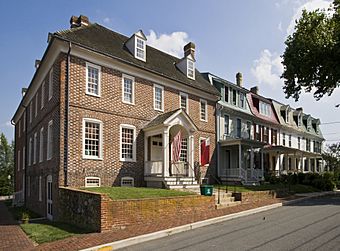Chestertown Historic District (Chestertown, Maryland) facts for kids
|
Chestertown Historic District
|
|

Custom House, 101 North Water Street and neighboring Victorian-era houses
|
|
| Location | Roughly bounded by Maple Ave., Chester River, Cannon and Cross Sts., Chestertown, Maryland and increase roughly bounded by Chester River, Lynchberg, and Cannon Sts., College Ave., Philosophers and Riverside Terrs., Chestertown, Maryland |
|---|---|
| Built | 1750 |
| Architect | Multiple |
| Architectural style | Georgian, Gothic Revival, Federal |
| NRHP reference No. | 70000263 (original) 84001808 (increase) |
Quick facts for kids Significant dates |
|
| Added to NRHP | April 15, 1970 (original) September 13, 1984 (increase) |
| Designated NHLD | April 15, 1970 |
The Chestertown Historic District is a special area in Chestertown, Maryland, that's full of old and important buildings. It's like a time capsule showing what the town was like long ago. This district was recognized as a National Historic Landmark and listed on the National Register of Historic Places in 1970. This means it's considered very important to the history of the United States. The area was made even larger in 1984 to include more historic spots.
Contents
Why Chestertown is Special
Chestertown is located right on the Chester River. From about 1750 to 1790, it was a very busy port, especially for shipping tobacco and wheat from the Eastern Shore of Maryland. Imagine ships coming and going, loaded with goods!
However, another city, Baltimore, grew much bigger and became the main port. Because Chestertown's port activity slowed down, many of its beautiful old buildings, especially homes, were preserved. There are more than fifty Georgian style townhouses here. These are homes built in a popular style from the 1700s.
In 1910, a big fire destroyed the main business area of Chestertown. But luckily, the historic residential area, where many of these old homes are, was not harmed. This helped keep the town's unique 18th-century look.
Famous Buildings in the District
The historic homes are mostly found along Water Street, between the business district and the Chester River. Here are some of the most interesting ones:
Hynson-Ringgold House
- Also known as "The Abbey," this house is at 100 South Water Street.
- It was built in 1767 by a merchant named Thomas Ringgold. He joined two older houses from 1735 to create one large, three-part home.
- The inside designs were done by a famous architect, William Buckland, between 1767 and 1771.
- Some of the original fancy wood paneling from the drawing room was moved to the Baltimore Museum of Art in the 1920s.
- The house was fixed up in the 1930s and is now where the president of Washington College lives.
Custom House
- This building is a three-story brick house at 101 South Water Street.
- It's believed to have been built by the Ringgold family in 1746.
- The first floor was used as a warehouse for goods, and people lived on the upper floors.
- This building served as Chestertown's custom house, where taxes were paid on imported and exported goods.
- A back section was added to the house in 1771.
Widehall
- Located at 101 North Water Street, Widehall is so important that it's also listed on the National Register of Historic Places by itself.
- Thomas Smythe built it around 1770.
- The outside of the house has been changed from its original Georgian style, but the fancy inside designs are still there.
River House
- Also called the Denton House, this house is at 107 North Water Street.
- It was built between 1737 and 1743 by William Timbrill, a merchant from Barbados.
- The inside of the house still has its original Georgian style. However, the outside has been changed to a Greek Revival style, which was popular later.
- The wood paneling from the third-floor master bedroom was bought by the Winterthur Museum in 1926.
Many other buildings on Water Street, High Street, and Queen Street are also part of this historic district.



